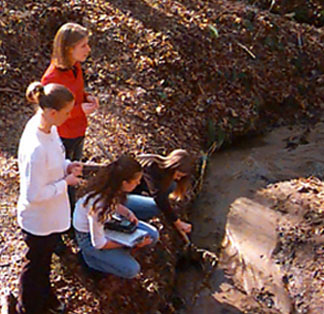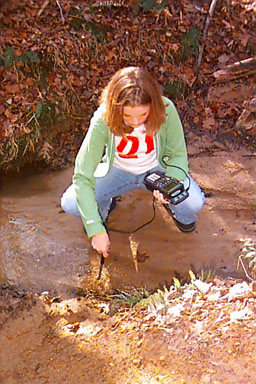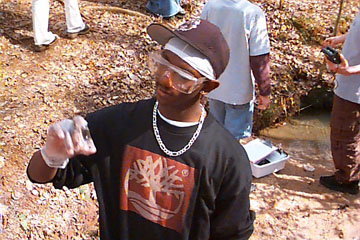Geotimes

Feature
A Victory for Earth
Science
Mary E. Watson and William Tucci
 The students
could tell something was wrong in the stream on the grounds of East Lincoln
High School in Denver, N.C.
The students
could tell something was wrong in the stream on the grounds of East Lincoln
High School in Denver, N.C.
The level of nitrate had shot up in the stream they were watching last spring.
As part of their earth and environmental science class, the students had been
monitoring the water quality. The stream was talking to them and the message
was familiar: nutrients.
They had been testing the stream’s water chemistry. When they found that
the level of nitrates had dramatically increased, they were intrigued. Through
scientific detective work, they found a possible answer. They hypothesized that
seepage from sewage systems was causing the nitrate level to spike.
The students’ excitement about the scientific process is one of the rewards
of the hard work of a group of determined people. It is the end of a story about
how these people brought the study of earth sciences into North Carolina’s
high schools.
Rallying the troops
In 1985, Charles “C.Q” Brown discovered that North Carolina was going
to take earth science out of eighth-grade classrooms. And its education administrators
weren’t planning to put it back in any of the other grade levels.
“This startling move seemed to come out of the blue, with no advance warning,”
says Brown, then chair of the geology program at East Carolina University. “My
first thought was, ‘What can we do to get it put back? We must change that
decision.’”
Brown began to assemble a group of geologists that would grow to include hundreds
of teachers, scientists and representatives from business and government. It
would, after 15 years of persistence, win a victory for earth science education.
In 1997, the State Board of Education approved making earth and environmental
science one of the three science courses the state’s high school students
must take before they graduate.
Reaction to the Board’s 1985 decision was not only swift but also echoed
from many academic and industry corners. Early brainstorming brought Brown together
with Fred Beyer, a public school system administrator; Floyd Mattheis, a science
educator at East Carolina University; and Fred Allen, director of the North
Carolina Aggregates Association, an industry group that has since actively worked
with the North Carolina Science Teachers Association and North Carolina educators.
They were the core of a pressure group, the Education and Industry Committee
for Earth Science in North Carolina, that became the foundation and source of
energy for the effort to initially restore earth science into the state’s
curriculum at all grade levels, and then to go further and make earth science
a graduation requirement.
“We needed to get some support to show that there is interest, not just
vested interest of geologists, but also to show why environmental science was
sound according to the principles of science instruction,” Brown says.
“We asked simply: ‘Why is earth science essential for the education
of the youth of North Carolina?’ In doing that, we got a broad spectrum
background to support the concept.”
The major players of the Committee were a diverse coalition of earth science
professionals and educators from industry, the North Carolina public school
system, the North Carolina Department of Public Instruction (NCDPI), the North
Carolina Aggregates Association, the North Carolina Geological Survey, the state
Department of Environment and Natural Resources, and North Carolina State University.
Other principal movers came from the federal agencies: the National Oceanic
and Atmospheric Administration, the National Weather Service and the Environmental
Protection Agency, and also state government agencies and the earth science
consulting community.
“You’ve just got to rally the troops and get as many people together
as you can to make a good, solid, active working group and a broad-based group,
so that you’re not trying to do it yourself,” Allen says. “There
were a number of organizations that were already working closely with the educational
system. It gave us some entry into being able to work with them.”
A strategic compromise
The Committee became strong and active. Its members wrote letters to the State
Board of Education, local school boards, superintendents, principals and chairs
of science instruction. They attended state and local school board meetings.
More importantly, its members spoke with school superintendents as often as
possible, even at 4H events. They continued to spread the same message: Students
need to know earth science to become good citizens.
 “We’re
missionaries out there, trying to spread the word and involve others in our
cause,” Allen says. “Marketing is probably the best way to describe
it, because it’s like selling any other product. I think we have to market
earth science in very much the same way.”
“We’re
missionaries out there, trying to spread the word and involve others in our
cause,” Allen says. “Marketing is probably the best way to describe
it, because it’s like selling any other product. I think we have to market
earth science in very much the same way.”
In 1992, it was time for the School Board to make a curriculum change, which
happens every four years. The Committee — by this time led by Alex Glover,
then a chief scientist for Vulcan Minerals Co. — saw its opportunity. They
would lobby for earth science to be a graduation requirement for high school
students.
The key to the committee’s success was also one of its compromises. They
decided to lobby not for just an earth science class, but for an earth and environmental
science class. This strategy garnered the support not only of earth scientists,
but also of environmental, marine, space and atmospheric scientists. The Committee
showed that a solid understanding of earth science is a key element for a solid
understanding of environmental science — that in fact earth science is
a stronger component of environmental science than even life science or physical
science, the two other graduation requirements.
East Lincoln High School students in Debbie
Michael’s earth and environmental science class spent a semester monitoring
the water quality of a stream on their school grounds. Photo courtesy of Debbie
Michael.
“I remember coming out of a meeting and thinking, ‘This is what’s
going to work for us,’” says Jake Brown, then High School Science
Consultant for the NCDPI.
“The reality of it is that when we talk about the environment, we talk
about the atmospheric sciences, the weather, the Earth, different kinds of soil
and rocks, weathering and erosion. When you get right down to it, the Earth
is part of environmental sciences. So, we decided to call this course earth
and environmental science.”
In this context, the Committee members emphasized that students need to know
earth science not only to be good citizens, but also to protect themselves from
the effects of natural disasters.
At a critical time, a key player entered the scene: meteorologist Rod Gonski
of the National Weather Service, who wrote letters to the School Board.
“In helping to push for the earth and environmental curriculum for high
school students, I would think back to findings from previous weather disasters
in North Carolina,” Gonski says. “One major tornado outbreak struck
central North Carolina and blew through heavily populated regions. The tornado
struck without warning in the middle of the night. More than 1,000 homes were
destroyed or heavily damaged. Yet, fatalities were limited to four. Later, interviews
with people in the path of the tornado found that people quickly recognized
what was happening and took prompt action to protect their lives. The difference
was education. For us to ignore those perils in the general education of our
young citizens would be to invite disaster once again.”
Point and counterpoint
In arguing for an earth and environmental science requirement, one objection
the Committee faced came from parents who thought requiring an earth science
course would make it harder for students to take Advanced Placement classes
and earn college credit.
“They said kids are only in high school for four years, and now you want
them to take three required science units. There’s no room for Advanced
Placement courses or electives, such as chemistry,’” Jake Brown recalls.
The Committee members argued that it wasn’t the job of the high school
just to give students courses for college credit. It is the schools’ job
to produce the best prepared kids in science education possible. Therefore,
it’s important for these children to have physical science, earth science
and life science.
Another argument was that the state didn’t have enough certified earth
science teachers to require an earth science course.
“Our counter was that those teachers will be there only when it’s
mandated they be,” Glover says. “Unless the law changes, there will
never be enough earth science teachers. When that is mandated, the availability
of the teachers will change.”
The third battle came from the heads of local school districts, who were reluctant
to relinquish control. In talking with superintendents, the Committee emphasized
again that students must learn earth science to be good citizens. “We made
the point, especially through the National Weather Service, that this knowledge
and lack of ignorance would save lives by people knowing about earth science,”
Glover says.
A success for earth science, for
students
 In 1998, the
opposition was crumbling. Neither group would claim all it sought, but the deal
was done. The State Board of Education directed that the earth and environmental
science curriculum would be part of a graduation requirement that would go into
effect students entering the ninth grade in 2000. Implementation was deferred
until the 2000-2001 school year, when earth science was also woven throughout
the curriculum of grades K-12. North Carolina is the first state to require
earth science in its standard course of study.
In 1998, the
opposition was crumbling. Neither group would claim all it sought, but the deal
was done. The State Board of Education directed that the earth and environmental
science curriculum would be part of a graduation requirement that would go into
effect students entering the ninth grade in 2000. Implementation was deferred
until the 2000-2001 school year, when earth science was also woven throughout
the curriculum of grades K-12. North Carolina is the first state to require
earth science in its standard course of study.
The new graduation requirement moved North Carolina toward a truly comprehensive
high school science curriculum. Educators and earth science professionals are
determined that students will acquire the knowledge and skills to deal with
the ever-increasing litany of environmental problems they will face.
One of Debbi Michael's students conducts a water quality test at a North Carolina
stream. Photo courtesy of Debbie Michael.
“I think we prevailed because we showed it was not in our self interest.
We showed that it was in the public’s interest,” Glover says.
For the earth science community, North Carolina is a success story that shows
how a group of earth scientists can influence their state’s science curriculum.
Giving students a chance to pursue outdoor science investigations of real-life
conditions in their own neighborhood — that is what the issue is all about.
“This fall the nitrates were extremely high, the kids wanted very much
to find out why,” teacher Debbie Michael says of her earth and environmental
science students. “Those kids were excited! … The creek now is their
creek, no question about that! Now they just beg to go down there and work that
stream.”
Watson works with the North
Carolina Geological Survey and Tucci works with the North Carolina Department
of Public Instruction. E-mail
 The students
could tell something was wrong in the stream on the grounds of East Lincoln
High School in Denver, N.C.
The students
could tell something was wrong in the stream on the grounds of East Lincoln
High School in Denver, N.C. 
 “We’re
missionaries out there, trying to spread the word and involve others in our
cause,” Allen says. “Marketing is probably the best way to describe
it, because it’s like selling any other product. I think we have to market
earth science in very much the same way.”
“We’re
missionaries out there, trying to spread the word and involve others in our
cause,” Allen says. “Marketing is probably the best way to describe
it, because it’s like selling any other product. I think we have to market
earth science in very much the same way.” In 1998, the
opposition was crumbling. Neither group would claim all it sought, but the deal
was done. The State Board of Education directed that the earth and environmental
science curriculum would be part of a graduation requirement that would go into
effect students entering the ninth grade in 2000. Implementation was deferred
until the 2000-2001 school year, when earth science was also woven throughout
the curriculum of grades K-12. North Carolina is the first state to require
earth science in its standard course of study.
In 1998, the
opposition was crumbling. Neither group would claim all it sought, but the deal
was done. The State Board of Education directed that the earth and environmental
science curriculum would be part of a graduation requirement that would go into
effect students entering the ninth grade in 2000. Implementation was deferred
until the 2000-2001 school year, when earth science was also woven throughout
the curriculum of grades K-12. North Carolina is the first state to require
earth science in its standard course of study. 